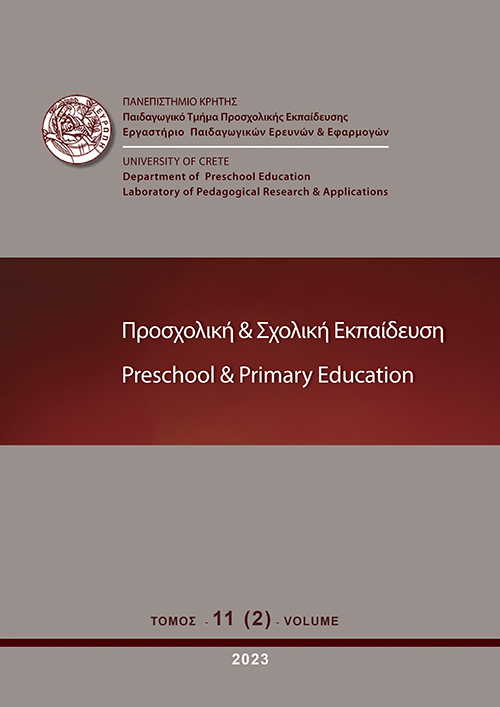Η «παιδαγωγική της ενσυναίσθησης» στο «Διαδικτυακό Σχολείο» της Περιφερειακής Διεύθυνσης Εκπαίδευσης Αττικής

Περίληψη
Η αναστολή της λειτουργίας των σχολείων κατά το ακαδημαϊκό έτος 2020-2021 ως απότοκο της επέκτασης της πανδημίας COVID-19 κατέστησε αναγκαία την ίδρυση ενός «Διαδικτυακού Σχολείου» για την εκπλήρωση των σύνθετων αναγκών των ευπαθών μαθητών. Αυτή η εργασία ασχολείται με τη δημιουργία ενός διαδικτυακού περιβάλλοντος ασφάλειας και φροντίδας, στο οποίο δίδαξαν ευπαθείς εκπαιδευτικοί εφαρμόζοντας την παιδαγωγική της ενσυναίσθησης, μια ολιστική προσέγγιση για την ανάπτυξη των γνωστικών και συναισθηματικών δεξιοτήτων των ευπαθών μαθητών. Η εν λόγω έρευνα είναι ποιοτική. Ελήφθησαν 50 συνεντεύξεις ανοιχτού τύπου από εκπαιδευτικούς και 15 από μαθητές και εφαρμόστηκε η μέθοδος της ποιοτικής ανάλυσης περιεχομένου. Σκοπός της έρευνας είναι να εξετάσει την επίδραση της παιδαγωγικής της ενσυναίσθησης στα μαθησιακά επιτεύγματα των μαθητών και να ανιχνεύσει τις διαστάσεις που ενδυνάμωσαν μαθητές και εκπαιδευτικούς. Σύμφωνα με τα ευρήματα της έρευνας, η παιδαγωγική της ενσυναίσθησης είχε παρακινητική επίδραση στις ακαδημαϊκές επιδόσεις των ευπαθών μαθητών. Αναδύθηκαν τέσσερις παιδαγωγικές συνιστώσες της ενσυναίσθησης: γνωστική, συναισθηματική, επικοινωνιακή και κοινωνικο-πολιτισμική. Τέλος, η τηλεκπαίδευση, ομόχρονη και ετερόχρονη, πρόταξε την ελπίδα για μια ποιοτική και χωρίς αποκλεισμούς εκπαίδευση, προσδίδοντας βαρύνουσα σημασία στο βίωμα της παιδαγωγικής σχέσης στη νέα «κανονικότητα» μετά την πανδημία.
Λεπτομέρειες άρθρου
- Πώς να δημιουργήσετε Αναφορές
-
Κόσυβας Γ. (2023). Η «παιδαγωγική της ενσυναίσθησης» στο «Διαδικτυακό Σχολείο» της Περιφερειακής Διεύθυνσης Εκπαίδευσης Αττικής. Preschool and Primary Education, 11(2), 207–237. https://doi.org/10.12681/ppej.31995
- Ενότητα
- Άρθρα

Αυτή η εργασία είναι αδειοδοτημένη υπό το CC Αναφορά Δημιουργού – Μη Εμπορική Χρήση – Παρόμοια Διανομή 4.0.
Οι συγγραφείς των άρθρων που δημοσιεύονται στο ΠΡΟΣΧΟΛΙΚΗ & ΣΧΟΛΙΚΗ ΕΚΠΑΙΔΕΥΣΗ διατηρούν τα δικαιώματα πνευματικής ιδιοκτησίας επί των άρθρων τους, δίνοντας στο περιοδικό το δικαίωμα της πρώτης δημοσίευσης. Άρθρα που δημοσιεύονται στο ΠΡΟΣΧΟΛΙΚΗ & ΣΧΟΛΙΚΗ ΕΚΠΑΙΔΕΥΣΗ διατίθενται με άδεια Creative Commons 3.0 και σύμφωνα με την άδεια μπορούν να χρησιμοποιούνται ελεύθερα, με αναφορά στο/στη συγγραφέα και στην πρώτη δημοσίευση για μη κερδοσκοπικούς σκοπούς και με δικαίωμα τροποποίησης μόνον με παρόμοια διανομή (αν αναμείξετε, τροποποιήσετε, ή δημιουργήσετε πάνω στο υλικό, πρέπει να διανείμετε τις δικές σας συνεισφορές υπό την ίδια άδεια όπως και το πρωτότυπο). To Εργαστήριο Παιδαγωγικών Ερευνών και Εφαρμογών του Παιδαγωγικού Τμήματος Προσχολικής Εκπαίδευσης του Πανεπιστημίου Κρήτης και το Εθνικό Κέντρο Τεκμηρίωσης διατηρούν το δικαίωμα να δημοσιεύουν, να αναπαραγάγουν, να παρουσιάζουν στο κοινό, να διανέμουν και χρησιμοποιούν άρθρα που δημοσιεύονται στο ΠΡΟΣΧΟΛΙΚΗ & ΣΧΟΛΙΚΗ ΕΚΠΑΙΔΕΥΣΗ σε οποιοδήποτε μέσο και μορφή είτε μεμονωμένα είτε ως μέρη συλλογικών έργων, για όλο το χρόνο διάρκειας προστασίας της πνευματικής ιδιοκτησίας και για όλες τις χώρες του κόσμου. Αυτό περιλαμβάνει ενδεικτικά και όχι αποκλειστικά, το δικαίωμα δημοσίευσης των άρθρων σε τεύχη του περιοδικού ΠΡΟΣΧΟΛΙΚΗ & ΣΧΟΛΙΚΗ ΕΚΠΑΙΔΕΥΣΗ, αναπαραγωγής και διανομής μεμονωμένων αντιγράφων των άρθρων, αναπαραγωγής ολόκληρων των άρθρων σε άλλη έκδοση του Εργαστηρίου Παιδαγωγικών Ερευνών και Εφαρμογών του Παιδαγωγικού Τμήματος Προσχολικής Εκπαίδευσης του Πανεπιστημίου Κρήτης και του Εθνικού Κέντρου Τεκμηρίωσης και αναπαραγωγής και διανομής των άρθρων ή περίληψης αυτών με χρήση πληροφορικού συστήματος αποθετηρίου.


